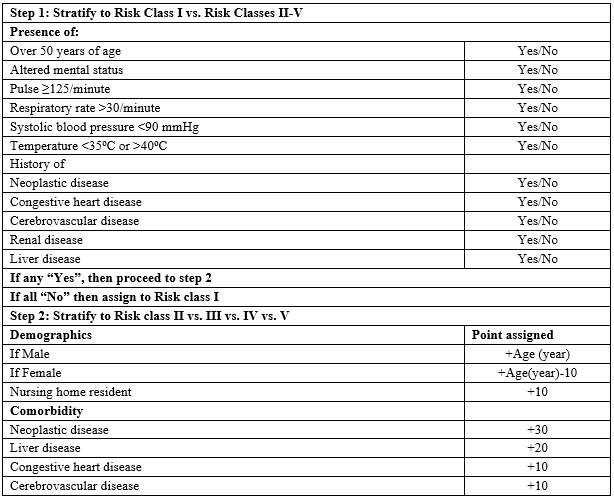A comparative study of PSI and Curb-65 scoring systems in predicting ICU admissions and mortality in cases of community-acquired pneumonia
Abstract
Background:Community-acquired pneumonia (CAP) is a leading cause of morbidity and mortality worldwide. Despite advanced diagnostic modalities and treatment options, CAP is the fourth leading cause of death in developing countries.Several severity scores have been proposed to guide initial decision making on hospitalization and to predict the outcome. Pneumonia Severity Index (PSI) and CURB 65 are the two most widely used scoring systems to prognosticate pneumonia.
Aim: To compare the efficacy of PSI and CURB 65 scoring systems inprognosticating the ICU admission and outcome in cases of CAP.
Methodology: This wasan observational study conducted at a tertiary care hospital in westernMaharashtra.A hundred patients of CAP fulfilling the inclusion criteria were enrolled in the study, classified as per CURB 65 and PSI system and their outcome compared.
Result: The study subjects comprised of 100 patients (64 men and 36 women) of CAP. Twenty-four patients needed ICU admission.In both PSI and CURB-65 risk scoring systems, the need for intensive care unit (ICU) admission and mortality rates increased progressively with increasing scores.PSI class ≥IV and CURB 65 ≥III had 77.52% and 40.24% sensitivity and 88.46% and 69.48% specificity respectively in predicting ICU admissions. The PSI class ≥IV had more sensitivity and specificity in predicting ICU admission than CURB-65.CURB 65 class III and IV had sensitivity86.59% and 89.64% and specificity 89.64% and 97.54% respectivelyin predicting mortality, while PSI class IV and Vhadsensitivity68.92% and 72.58% and specificity 24.74% and 54.86% respectively. CURB 65 had more sensitivity and specificity than PSI in predicting mortality.
Conclusion: The PSI is better in predicting the need for ICU admission and CURB 65 is a better predictor of mortality in cases of community-acquired pneumonia.
Downloads
References
Regional situation on health statistics reporting. Health Situation in the South-East Asia Region 201-2007. New Delhi: EHI/WHO-SEARO; 2007. Available from https://apps.who.int/iris/bitstream/ handle/ 10665/205256/B3226.pdf?sequence=1&isAllowed=y
Farooqui H, Jit M, Heymann DL, Zodpey S. Burden of severe pneumonia, pneumococcal pneumonia and pneumonia deaths in Indian states: Modelling based estimates. PLoS One 2015;10(6):e0129191. eCollection 2015.doi: https://doi.org/10.1371/journal.pone.0129191.
Prasad P, Bhat S. Clinicomicrobiological study of community acquired pneumonia. Lung India 2017;34(5):491-492. doi: https://doi.org/10.4103/lungindia.lungindia_89_17.
Woodhead MA, Welch CA, Harrison DA, Bellingan G, Ayres JG. Community-acquired pneumonia on the intensive care unit: secondary analysis of 17,869 cases in the ICNARC case mix programme data base. Crit Care.Crit Care. 2006;10(2):S1. doi: https://doi.org/10.1186/cc4927.
Shah BA, Ahmed W, Dhobi GN, Shah NN, Khursheed SQ, Haq I. Validity of pneumonia severity index and CURB 65 severity scoring systems in community acquired pneumonia in an Indian setting. Indian J Chest Dis Allied Sci. 2010;52(1):9 17.
Fine MJ, Auble TE, Yealy DM, Hanusa BH, Weissfeld LA, Singer DE, et al. A prediction rule to identify low risk patients with community acquired pneumonia. N Engl J Med. 1997;336(4):243 250. doi: https://doi.org/10.1056/NEJM199701233360402.
Lim WS, Baudouin SV, George RC, Hill AT, Jamieson C, Le Jeune I, et al. BTS guidelines for the management of community acquired pneumonia in adults: update 2009. Thorax. 2009;64(3):iii1-55.doi: https://doi.org/10.1136/thx.2009.121434.
Shah BA, Singh G, Naik MA, Dhobi GN. Bacteriological and clinical profile of Community acquired pneumonia in hospitalized patients. Lung India 2010;27(2):54 57. doi: https://doi.org/10.4103/0970-2113.63606.
Mohanty S, Babu VH. comparative study of newer prognostic scoring systems in predicting severity in community acquired pneumonia in hospitalized patients. IOSR-JDMS,2016;15(6):146-152.doi: https://doi.org/10.9790/0853-150602146152.
Akhila Babu, Nybin Jose, JonaJoseA Prospective Observational Study to Evaluate the Severity Assessment Scores in Community‑acquired Pneumonia for Adult Patient. Indian J Respir Care. 2017;6(2):820-823. doi: https://doi.org/10.4103/ijrc.ijrc_16_17.
Dey AB, Nagarkar KM, Kumar V. Clinical presentation and predictors of outcome in adult patients with community acquired pneumonia. National Med J India. 1997;10(4):169-172.
Madhu S, Augustine S,Kumar YSR, Kauser MM, Kumar SRV, Jayaraju BS. Comparative study of CURB-65, Pneumonia Severity Index and IDSA/ATS scoring systems in community acquired pneumonia in an Indian tertiary care setting. Int J Adv Med. 2017;4(3):693-700 doi: http://dx.doi.org/10.18203/2349-3933.ijam20172088.

Copyright (c) 2020 Author (s). Published by Siddharth Health Research and Social Welfare Society

This work is licensed under a Creative Commons Attribution 4.0 International License.


 OAI - Open Archives Initiative
OAI - Open Archives Initiative


